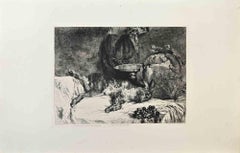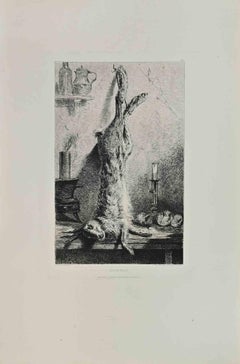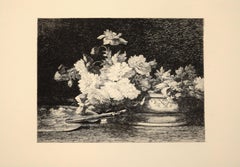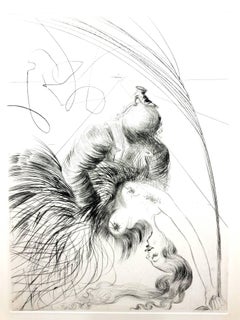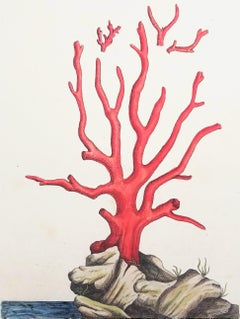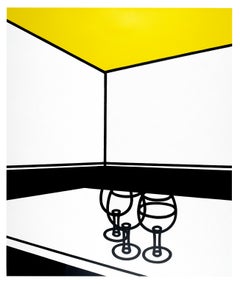1870s Still-life Prints
to
3
Overall Width
to
Overall Height
to
2
1
1
216
246
2,355
1,644
17
19
36
28
91
248
348
465
546
216
186
2
1
2
2
2
1
1
1
3
2
Period: 1870s
Un Coin de Cuisine - Etching by Charles Meryon - 1870s
Located in Roma, IT
Un Coin de Cuisine is an artwork realized by Charles Meryon in the 1870s.
Etching.
Image size:24x31.
Good conditions.
Realized for the "Société des Aquafortistes. Born on the i...
Category
Modern 1870s Still-life Prints
Materials
Etching
Nature Morte - Etching by Leon Gaucherel - 1860s
Located in Roma, IT
Nature Morte is an artwork realized by Leon Gaucherel in the 1870s.
Etching.
Image size: 31 x 19
Good condition.
Realized for the "Société des Aquafortistes. Born on the initi...
Category
Modern 1870s Still-life Prints
Materials
Etching
Vase de Fleurs - Etching by Louis Lemaire - 1870s
Located in Roma, IT
Vase de Fleurs is an original artwork realized by Louis Lemaire in 1870. Original etching on paper.
Artist's proof, before letter.
Good conditions, e...
Category
1870s Still-life Prints
Materials
Etching
Related Items
Silent Snow (Poetical imagery and Christmas memories in New England)
By Mary Teichman
Located in New Orleans, LA
This image is from an exclusive edition published by Stone + Press in 1994 in an edition of 100. This impression is #98. It brings to mind the Robert Frost poem, Stopping by Woods on a Snowy Evening.
The woods are lovely, dark and deep,
But I have promises to keep,
And miles to go before I sleep,
And miles to go before I sleep.
Mary Teichman...
Category
American Modern 1870s Still-life Prints
Materials
Etching
$100 Sale Price
20% Off
H 5.75 in W 3.75 in
Salvador Dali - The Woman of the Shoe - Original Stamp-Signed Etching
Located in Collonge Bellerive, Geneve, CH
Salvador Dali - The Woman of the Shoe - Original Stamp-Signed Etching
Stamp signed by Dali
Edition of 294 copies.
Paper : Arches vellum.
Dimensions : 16x12".
Catalogue Raisonné : ...
Category
Surrealist 1870s Still-life Prints
Materials
Etching
$1,795
H 16 in W 12 in D 0.1 in
Salvador Dali - The Violet Boot - Original Stamp-Signed Etching
Located in Collonge Bellerive, Geneve, CH
Salvador Dali - The Violet Boot - Original Stamp-Signed Etching
Stamp signed by Dali
Edition of 294 copies.
Paper : Arches vellum.
Dimensions : 16x12".
Catalogue Raisonné : Field ...
Category
Surrealist 1870s Still-life Prints
Materials
Etching
$1,797
H 16 in W 12 in D 0.1 in
Magnolia 10 - Contemporary Figurative Drypoint Etching Print, Flower, Floral
Located in Warsaw, PL
MARTA WAKUŁA-MAC: Master of Arts in Fine Art Education- Diploma in Fine Art Printmaking at the Institute of Art, Pedagogical University, Krakow, 2003. Member of Graphic Studio Dubl...
Category
Contemporary 1870s Still-life Prints
Materials
Paper, Drypoint, Etching
Pair of Hand-colored Romantic French Engravings after Francois Boucher
By (After) Francois Boucher
Located in Alamo, CA
A pair of French classical romantic prints original created in the 18th century by Jacques-Firmin Beauvarlet (1731-1797) after paintings by Francois Boucher (1703-1770), utilizing ...
Category
Romantic 1870s Still-life Prints
Materials
Engraving, Etching
$2,375
H 28.5 in W 23.63 in D 1.13 in
Salvador Dali - The Winged Demon - Original Stamp-Signed Etching
Located in Collonge Bellerive, Geneve, CH
Salvador Dali - The Winged Demon - Original Stamp-Signed Etching
Stamp signed by Dali
Edition of 294 copies.
Paper : Arches vellum.
Dimensions : 16x12"....
Category
Surrealist 1870s Still-life Prints
Materials
Etching
$2,995
H 16 in W 12 in D 0.1 in
The pot boiling by David Hockney (Six Fairy Tales from the Brothers Grimm)
Located in New York, NY
From David Hockney’s celebrated Six Fairy Tales from the Brothers Grimm portfolio, an image from the story of ‘Fundevogel’. One of just a few in the series that depicts a single form with such complexity, drawn directly on the plate by Hockney. This is certainly an ode to Giorgio Morandi’s etchings...
Category
1870s Still-life Prints
Materials
Etching, Aquatint
Zen Minimalist Flowers Etching American Modernist Ed Baynard Pop Art Print
By Ed Baynard
Located in Surfside, FL
ED BAYNARD (American, 1940-2016)
Flowers, Flowers in a Vase, Etching.
1979/1980,
Hand signed, dated l.r.,
Hand numbered from small edition 12/24,
Dimensions: 23 by 19 in. Framed 25 by 21 in
Born in Washington, D.C. in 1940. Raised in Washington, D.C. and newly graduated from high school, he flew to Europe living off and on in Paris and London. During this time, he designed costumes for Jimi Hendrix, worked as a graphic designer for the Beatles as well as Elizabeth Taylor and Richard Burton. Returning to New York, he dedicated his life to art after a surprise success with his first show in 1971 at the Willard Gallery in NYC. Ed's images are Zen-like in their simplicity and grace rendered in a flat, graphic style that recalls Japanese Ukiyo-e prints. His watercolors are luminous, like the rest of his representations regardless of the medium. The Japanese inspired ukiyo-e style woodblock prints and lithograph works he created at Tyler Graphics in 1980 contain a 20th century "floating world" sensibility. Ed's wish was to bring harmony, color, and a meditative stillness to this chaotic planet. He did so in a gentle and powerful way, always as an expression of his deep gratitude for the love and beauty, friendship, and concerns he held dearest. His first solo exhibition was in 1971 at New York's legendary Willard Gallery on the recommendation of Agnes Martin. Baynard went on to have exhibitions at galleries including Betty Parsons Gallery, New York (1973); Marian Goodman Gallery, New York (1977); John Berggruen Gallery, San Francisco (1980); and Barbara Gladstone Gallery, New York (1980/81).. Baynard manages to retain a simplicity of form inspired by a love of Japanese Woodblock prints. His new works reflect the same poetry of his earlier paintings, retaining his stylized compositions with their Zen like minimalism and Oriental calm, along with a new sense of rhythm and movement. Baynard uses familiar themes such as flowers, plants, pots, and vases, incorporating them into his delicate watercolor still lifes, thus creating stunning visual feasts. He was included in the 1972 Landscape exhibition at MoMA NY alone with other luminaries James Boynton...
Category
American Modern 1870s Still-life Prints
Materials
Etching
Magnolia 11 - Contemporary Figurative Drypoint Etching Print, Flower, Floral
Located in Warsaw, PL
MARTA WAKUŁA-MAC: Master of Arts in Fine Art Education- Diploma in Fine Art Printmaking at the Institute of Art, Pedagogical University, Krakow, 2003. Member of Graphic Studio Dubl...
Category
Contemporary 1870s Still-life Prints
Materials
Drypoint, Paper, Etching
Zen Minimalist Flowers Etching American Modernist Ed Baynard Pop Art Print
By Ed Baynard
Located in Surfside, FL
ED BAYNARD (American, 1940-2016)
Flowers, Flowers in a Vase, Etching.
1979/1980,
Hand signed, dated l.r.,
Hand numbered from small edition 12/24,
Dimensions: 23 by 19 in. Framed 25 by 21 in
Born in Washington, D.C. in 1940. Raised in Washington, D.C. and newly graduated from high school, he flew to Europe living off and on in Paris and London. During this time, he designed costumes for Jimi Hendrix, worked as a graphic designer for the Beatles as well as Elizabeth Taylor and Richard Burton. Returning to New York, he dedicated his life to art after a surprise success with his first show in 1971 at the Willard Gallery in NYC. Ed's images are Zen-like in their simplicity and grace rendered in a flat, graphic style that recalls Japanese Ukiyo-e prints. His watercolors are luminous, like the rest of his representations regardless of the medium. The Japanese inspired ukiyo-e style woodblock prints and lithograph works he created at Tyler Graphics in 1980 contain a 20th century "floating world" sensibility. Ed's wish was to bring harmony, color, and a meditative stillness to this chaotic planet. He did so in a gentle and powerful way, always as an expression of his deep gratitude for the love and beauty, friendship, and concerns he held dearest. His first solo exhibition was in 1971 at New York's legendary Willard Gallery on the recommendation of Agnes Martin. Baynard went on to have exhibitions at galleries including Betty Parsons Gallery, New York (1973); Marian Goodman Gallery, New York (1977); John Berggruen Gallery, San Francisco (1980); and Barbara Gladstone Gallery, New York (1980/81).. Baynard manages to retain a simplicity of form inspired by a love of Japanese Woodblock prints. His new works reflect the same poetry of his earlier paintings, retaining his stylized compositions with their Zen like minimalism and Oriental calm, along with a new sense of rhythm and movement. Baynard uses familiar themes such as flowers, plants, pots, and vases, incorporating them into his delicate watercolor still lifes, thus creating stunning visual feasts. He was included in the 1972 Landscape exhibition at MoMA NY alone with other luminaries James Boynton...
Category
American Modern 1870s Still-life Prints
Materials
Etching
Bodegon, 1979 Signed Abstract Still Life Etching by Juan Manuel Gomez-Quiroz
Located in Long Island City, NY
Bodegon by Juan Manuel Gomez-Quiroz, Chilean (1939–2021)
Date: 1979
Etching, signed, titled, numbered and dated in pencil
Edition of 65
Image Size: 29.5 x 23.5 inches
Size: 35.75 x 2...
Category
Abstract 1870s Still-life Prints
Materials
Etching
Elegant Flower etching, signed/n Artists Proof, from Estate of renowned curator
Located in New York, NY
Lowell Nesbitt
Untitled Flower, 1975
Etching on wove paper
Hand signed, numbered AP and dated on the front
24 × 19 inches
Image alone:
9.5 inches (vertical) x 5.75 inches (horizontal...
Category
Modern 1870s Still-life Prints
Materials
Etching
Previously Available Items
Red Coral (Corallium Rubrum) /// Elizabeth Blackwell Female Botanical Artist Art
By Elizabeth Blackwell
Located in Saint Augustine, FL
Artist: Elizabeth Blackwell (Scottish, 1699-1758)
Title: "Red Coral (Corallium Rubrum)" (Vol. 2, Plate 341)
Portfolio: A Curious Herbal
Year: 1737-1739 (First edition)
Medium: Origin...
Category
Victorian 1870s Still-life Prints
Materials
Watercolor, Laid Paper, Engraving, Intaglio
Black and White Café - Patrick Caulfield, Screenprint, Pop Art, Prints
Located in London, GB
From the 'Rothko Memorial Portfolio'.
Signed and numbered in pencil, numbered from the edition of 75.
Printed on Aquarelle Arches Satine paper at Kelpra Studios, London.
Published...
Category
Pop Art 1870s Still-life Prints
Materials
Screen
Godetia
Located in London, GB
Signed and dated in pencil, numbered from the edition of 100.
Printed on Arches mould-made paper by Atelier Crommelynk, Paris.
Published by Petersburg Press, London.
(Scottish Arts C...
Category
Pop Art 1870s Still-life Prints
Materials
Etching, Aquatint
